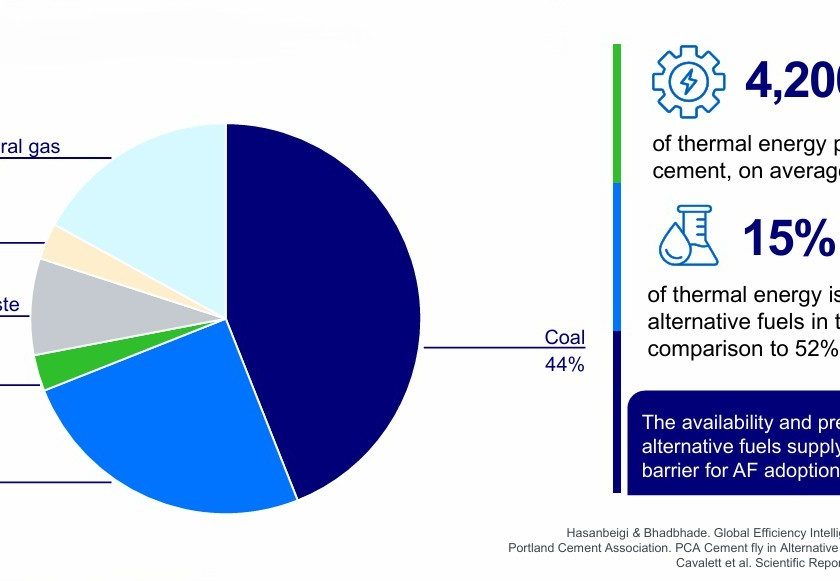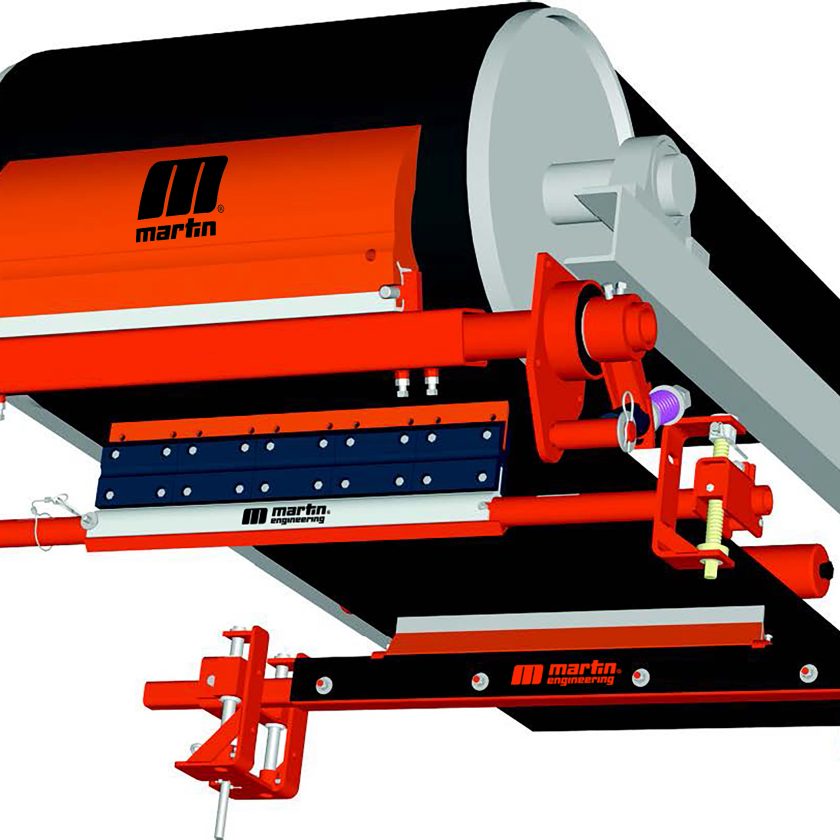By Fabio Mielli
Energy efficiency in cement plants is a central topic of concern. It’s a delicate and multifaceted variable that involves government regulations, societal pressures, cost and competitiveness. A cement producer successful in energy efficiency is synonymous of a successful company. As proof, recent Bloomberg research noticed that green companies from basic resources sectors perform 5% to 10% better (based on stock price performance) against the other companies in the same sector.
Making this a global issue is the fact that cement manufacturing is responsible for 2% of global energy consumption. According to the Environmental Defense Fund, in the United States, this amounts to $1.67 billion per year (cost) with energy intensity (costs vs. shipments) of 18%. The objective of this article is to describe the energy efficiency challenges for the cement industry and present a four-step process to address these challenges.
The energy dilemma that the world faces is clearly one of supply and demand in the face of political and social pressures to protect the environment. The answers will need to come from all fronts, but for the short term, it is vital for companies to realize that the best renewable energy is one that is not used.
One kilowatt saved at any point in the production process is equivalent to 3 kilowatts saved in generation, distribution, and consumption. Compounding this savings is the realization that renewable technologies are not yet fully implemented today, and cannot practically meet current demand due to cost and infrastructure limitations. This makes fully replacing traditional sources of power not only impractical, but also logistically impossible, with significant private as well as public sacrifice. As a result, the best possible solution for closing the gap between demand, production and environment impact of energy production is to reduce consumption through the improvement of processes and implementation of new technologies.
CHALLENGES
Some studies acknowledge the cement industry can reduce its energy use by 25% to 30% using available technologies. However, some challenges have to be tackled to achieve such results:
- Justify an energy efficiency project or initiative – One of the major challenges for energy efficiency initiatives is to justify financially the initiative itself. From short-term initiatives with fast results to a more expensive approach and long-term return, the user has to identify the best financial approach to calculate the return of the investment.
- Limited information or an excess of information – Cement producers traditionally don’t have enough granularity information about their own energy consumption to make critical decisions. In many cases, energy consumption data is limited to main feeders, and in the end, the energy cost isn’t properly allocated to process, areas, and cost centers with accurate information. Unfortunately, it is not uncommon for corporations to arbitrarily allocate energy costs across all existing process areas and departments.
On the flip side, in some corporations, technological advances, specifically in the area of automation and control, have exponentially increased the amount of data available causing an overload. This excess of data has had unintended consequences by making it difficult to pinpoint analyze and evaluate the important details or worse, cause operational personal to come to the wrong conclusions based on misleading data from different sources. - No systematic/consistent approach to energy improvement – Energy efficiency initiatives don’t bring long-term and stable returns if treated as remediation, just fixing problems. To realize the true value of an energy improvement initiative, companies need to look at the long-term impact of their actions and measure both the immediate savings and long-term savings as an annuity.
- Identify energy drivers and consumption context – Every process has sub-processes that contribute to the overall energy consumption equation. Businesses need to truly investigate and measure these processes to determine the specific energy drivers. These energy drivers are the main variable that influence the energy consumption equation and are the key to reducing consumption and influencing the energy-intensity concept. Increasing throughput, for example, uses more energy, but may not result in a significant increase in energy intensity. Measuring this process individually will allow corporations to make a critical evaluation to determine if the increase in energy usage is due to increased production or waste and make a determination on its specific value.
- Accountability – For several years, operators were responsible for production output, regardless of the optimal energy for that process. The challenge is to get real-time information for cost center and production units in order to help operators understand the cost of their process decisions and actions.
THE FOUR-STEP STRATEGY FOR IMPROVEMENT
We suggest a four-step approach for energy efficiency continuous improvement:
1. Measure
The first step is doing an energy analysis, identifying the major points of measurement, collecting energy information, and determining the energy drivers. This measurement can be manually performed, but the installation of metering systems is recommended for the most critical loads.
Before starting an improvement program, measurement and benchmarking helps determine where and to what degree energy is wasted. It also provides a baseline for future comparison. Measurement during the monitoring stage helps identify deviations that need to be corrected, in order to sustain the savings. Besides metering systems, modern motor protection relays and advanced circuit breakers are able to deliver energy information, allowing more load granularity to obtain energy consumption data.
2. Fix the basics
The initial results typically reveal areas that can be addressed and remedied without outside help. Often, basic housekeeping process improvements can reduce waste and trim utilization to meet basic energy efficiency targets. High-efficient motors, power factor correction, lighting, and compressed air leaks are common starting places that can benefit from the introduction of passive devices that, by nature, consume less energy.
3. Automate
This step implies the use of active elements (active elements regulate processes to achieve energy efficiency), such as automation systems to regulate energy usage.
Automation and Advanced Process optimization – In the cement industry, the two major targets for process optimization are the grinding and kiln, as they are the major electrical and thermal energy consumers.
Advanced process control (APC) and optimization techniques using neural networks, fuzzy logic, and expert systems are strong allies for energy efficiency, since they deliver the optimum particle size for grinding (avoiding over grinding and energy waste) and promote the best kiln combustion process, using fuel in its optimum format to reduce emissions. Modern APC strategies are easy to implement and after completion require little maintenance and run embedded within the control systems.
Production Optimization – Manufacturing execution systems (MES), combined with an energy management system (EMS), provide the ability to optimize energy utilization. This approach combines the best of two worlds. Manufacturing intelligence tools: production, maintenance, downtime, and financials, with data contextualized to understand energy intensity. This gives users real-time data production information associated with energy drivers and allows them to forecast energy usage, since it generates an energy model against production scenarios.
In parallel, such technology drives dynamic objectives, where the new energy target is compatible with new production scenario. Fixed objectives aren’t always appropriate if production has new characteristics.
New technologies and processes – After all the basic approaches, more advanced actions can be performed in a cement plant. Technologies such waste heat recovery and new alternative fuels also can be taken into consideration after a deeper return of investment analysis.
4. Monitor and Control
Continuous improvement is necessary over time. Achievements can be lost if a systematic approach isn’t implemented and doesn’t have the whole company participation.
As mentioned before, energy management systems are strong allies for constant energy monitoring. According to a recent report from Verdantix, carbon and energy management software tools will grow more than 50% between 2010 and 2014. However, the study also points out that construction and base materials companies will have a modest investment against other energy-intensive processes, such as the oil & gas and telecommunication sectors.
Virtual control rooms—Systems based on Ethernet/wireless and internet technologies allow different cement plants being monitored from single locations and benchmark against each other. Similar processes from different plants can be compared and best practices exchanged.
JUSTIFYING THE PROJECT
Basic energy efficiency training includes dedicated modules just for project financial analysis. This ensures that return on investment (ROI) analysis is not comprised of just a single component. Instead, it is a collection of methods, skills, tools, activities, and ideas. These can then be combined and used in many different ways to assess the relative value of an investment over time. Applying this collection in a particular situation requires making choices among the ideas and methods available and conducting an analysis appropriate to the decision at hand.
CONCLUSION
Sustainable cement manufacturing requires a combined approach of technology, software tools, and indidual behavior. Also a partnership with a trusted vendor can help cement producers perform an audit plan and find solutions to be more efficient, productive, and green.
Fabio Mielli is the U.S. mining, metals and minerals segment manager for Schneider Electric. An electrical engineer, Mielli has been with Schneider Electric for 16 years and is based in Georgia. He has 20 years of experience in speed drives, automation, and industrial control, and has worked closely with the major mining and metals producers. He can be reached at [email protected].



